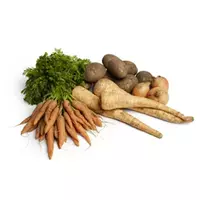Root crops

In many world national culinary traditions, you can easily find dozens, and sometimes hundreds of recipes for preparing various dishes using root crops. At its biological essence, root crops are an integral part of the plant, which is located underground and often mistakenly associated with the rhizome.
Types of root crops
Many types of root crops throughout the history of human civilization are actively consumed by people. In addition, the useful properties of root crops are used in folk medicine. as well as in pharmacological and cosmetic production. As a rule, root crops are famous for their vitamin and mineral composition, as well as nutritional content.
The distinctive properties of root crops are due to the chemical composition of this part of the plant, in which the supply of elements necessary for growth, as well as vitamins and other compounds, is concentrated. Specialists in the modern food industry operate with such a concept as table root crops. In turn, table root crops mean juicy underground components of crops that are grown for culinary use.
In addition to cooking, root crops are used as highly nutritious and contain a significant amount of vitamins for pets. All types of root crops belong to such plant families as Umbrella, for example carrots, parsnips or parsley, as well as Astrovs, for example scorzonera and cabbage, i. e. turnip, swede or radish.
Composition of root crops
The chemical composition of root crops, however, as well as other main biological and consumer characteristics of products, depend primarily on the species belonging to the plant. However, it should be especially emphasized that all types of root crops boast a unique and naturally balanced vitamin-mineral composition, which is enriched with a significant amount of truly vital compounds for both the plant and the human body.
The composition of root crops contains nutrients, as well as vitamins of group C, A, E, PP. In addition, root crops include essential amino acids, minerals, natural sugar-containing and pectin compounds. Eating root crops regularly can significantly improve a person's health.
The benefits of root crops
The uniqueness of the benefits of root crops for humans is primarily due to the chemical composition of this part of valuable vegetable and agricultural crops. The benefits of root crops extend to the entire human body as a whole. It is noteworthy that roots have long been used not only for culinary purposes. but also as an effective drug.
We think many have heard about infusions, as well as decoctions that are prepared with the participation of both root crops themselves and plant greens. Due to the fairly low average caloric level of root crops, as well as the excellent chemical composition, foods are often included in a dietary or therapeutic-preventive diet.
root crops 118 kCal
Energy value of root crops (Ratio of proteins, fats, carbohydrates - ju):
Proteins: 1.53 g (~ 6 kCal)
Fats: 0.17 g (~ 2 kCal)
Carbohydrates: 23.78 g (~ 95 kCal)
Energy ratio (bj | y): 5% | 1% | 81%
 Español
Español Français
Français Português
Português Русский
Русский 简体中文
简体中文 繁體中文
繁體中文 日本語
日本語 한국어
한국어 العربية
العربية Türkçe
Türkçe Қазақ
Қазақ Deutsch
Deutsch Italiano
Italiano Українська
Українська
